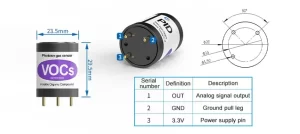Indoor air quality has become an increasingly important topic in recent years, as we spend more and more time inside our homes and offices. Poor air quality can have a negative impact on our health, causing respiratory problems, headaches, and other health issues. However, with the help of gas sensors, we can now monitor and improve the quality of the air we breathe.

Gas sensors are devices that detect and measure the concentration of gases in the air
They can detect a wide range of gases, including carbon monoxide, nitrogen dioxide, and volatile organic compounds (VOCs). These gases can be produced by a variety of sources, such as gas stoves, cleaning products, and building materials.
One of the main benefits of gas sensors is that they can alert us to the presence of harmful gases before they reach dangerous levels. For example, carbon monoxide is a colorless, odorless gas that can be deadly in high concentrations. Gas sensors can detect even small amounts of carbon monoxide and alert us to the danger before it becomes a serious threat.
Gas sensors can also help us identify the sources of indoor air pollution. By monitoring the concentration of different gases over time, we can determine which activities or products are causing the most pollution. This information can help us make changes to our behavior or environment to reduce the amount of pollution we are exposed to.
In addition to monitoring indoor air quality, gas sensors can also be used to improve it. For example, some buildings use gas sensors to control ventilation systems. When gas sensors detect high levels of pollution, they can trigger the ventilation system to bring in fresh air from outside. This can help reduce the concentration of pollutants in the air and improve overall air quality.
Another way gas sensors are improving indoor air quality is by enabling the development of smart homes. Smart homes use sensors and other connected devices to automate and optimize various aspects of the home, including heating, lighting, and air conditioning. Gas sensors can be integrated into smart home systems to monitor indoor air quality and adjust the ventilation and air conditioning systems accordingly.
Gas sensors are also being used in commercial buildings to improve indoor air quality. For example, some office buildings use gas sensors to monitor the concentration of carbon dioxide in the air. High levels of carbon dioxide can indicate poor ventilation, which can lead to a range of health problems. By monitoring carbon dioxide levels and adjusting ventilation systems as needed, these buildings can provide a healthier and more comfortable environment for their occupants.

Overall, gas sensors are an important tool for improving indoor air quality. They can help us identify and mitigate sources of indoor air pollution, alert us to the presence of harmful gases, and enable the development of smart homes and buildings. As we continue to spend more time indoors, the importance of indoor air quality will only continue to grow, and gas sensors will play a crucial role in ensuring that we can breathe easy.
 : +86 155 8830 2704
: +86 155 8830 2704 : jxdziot@gmail.com
: jxdziot@gmail.com
